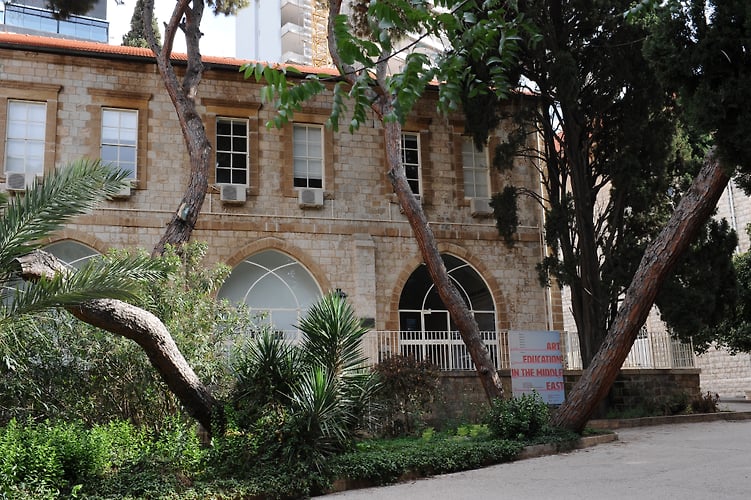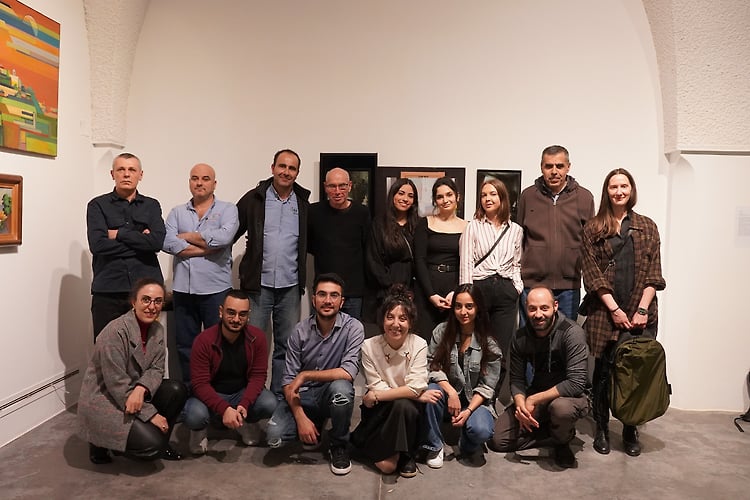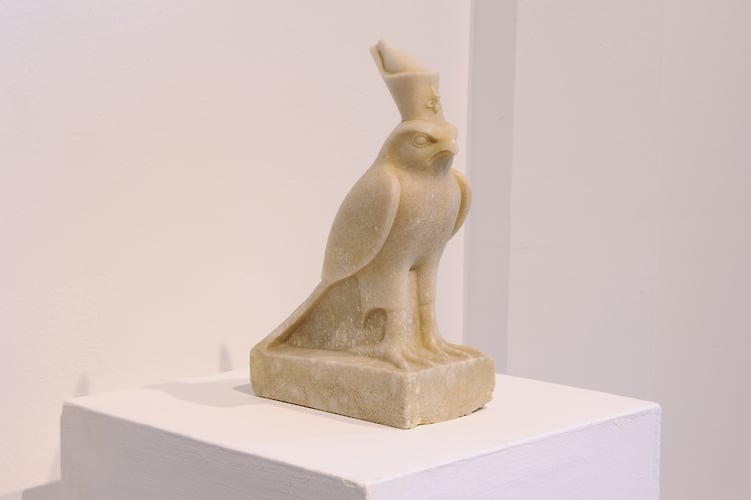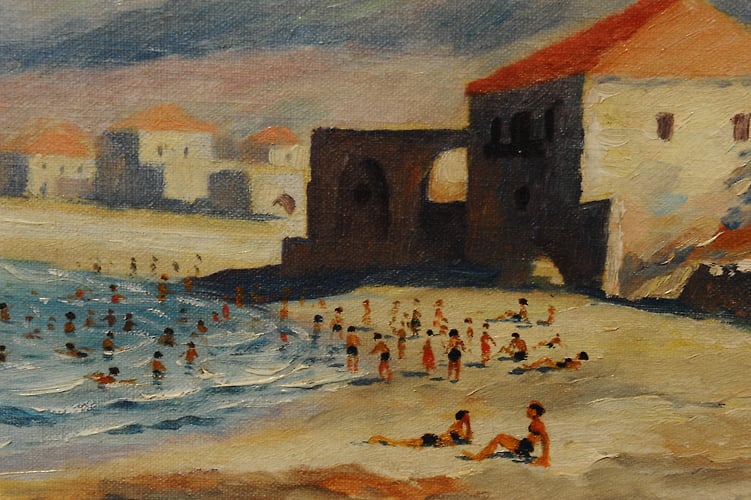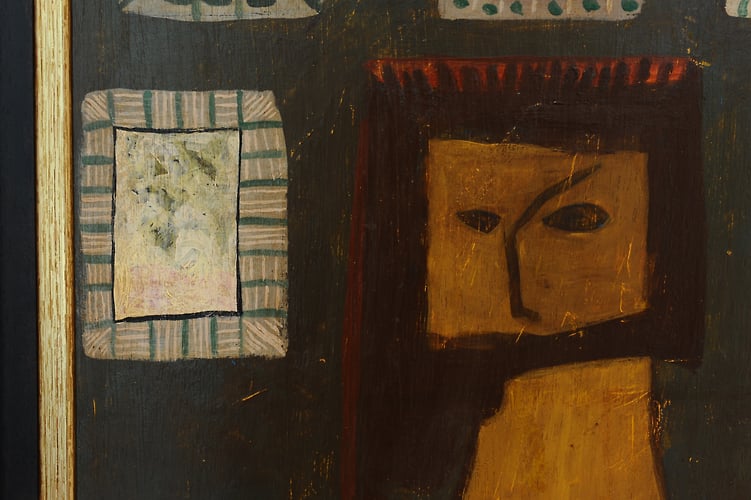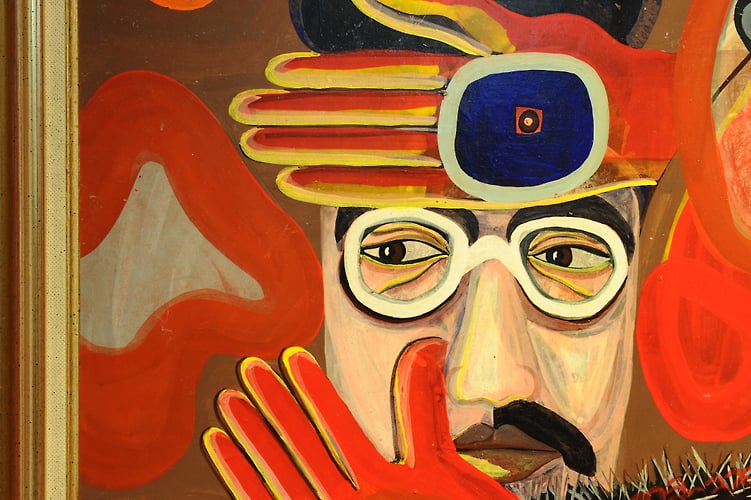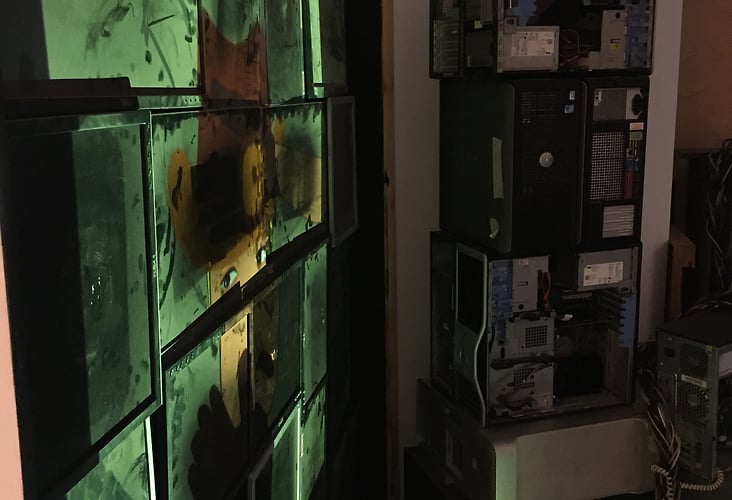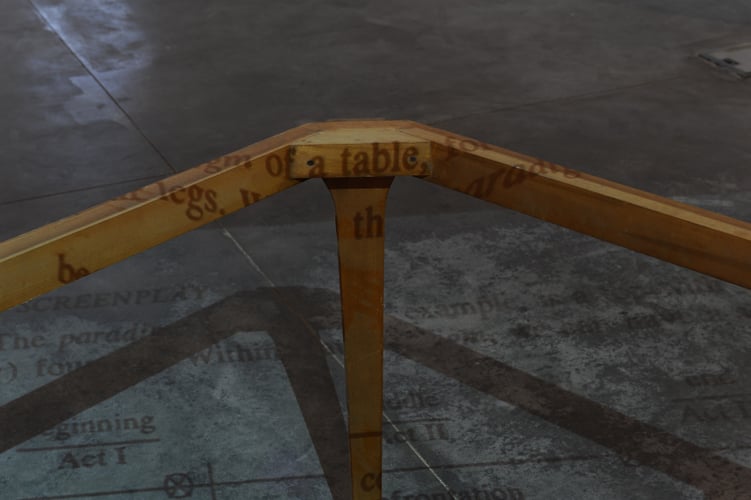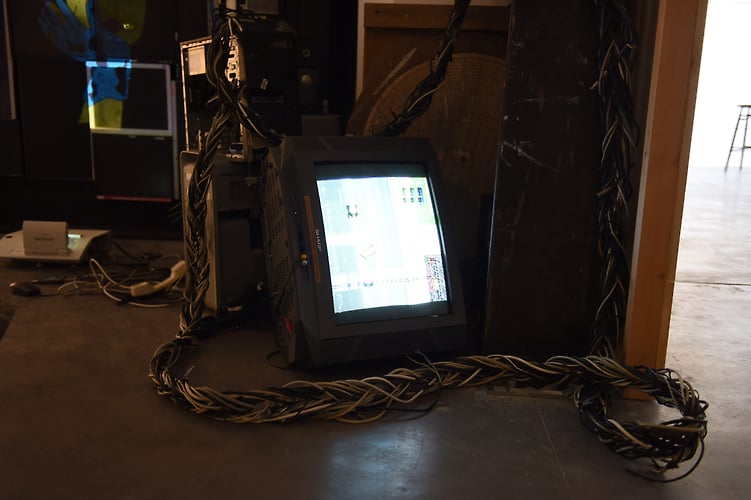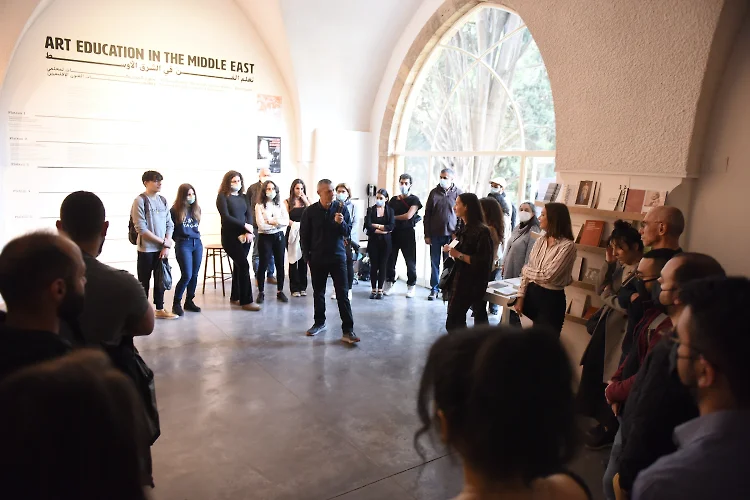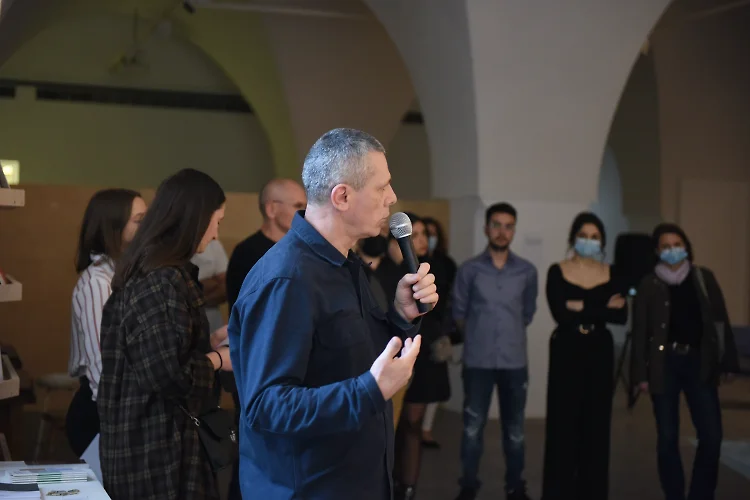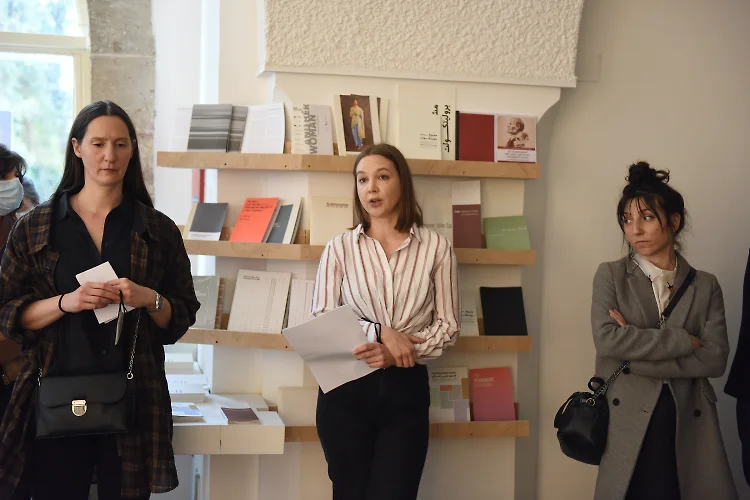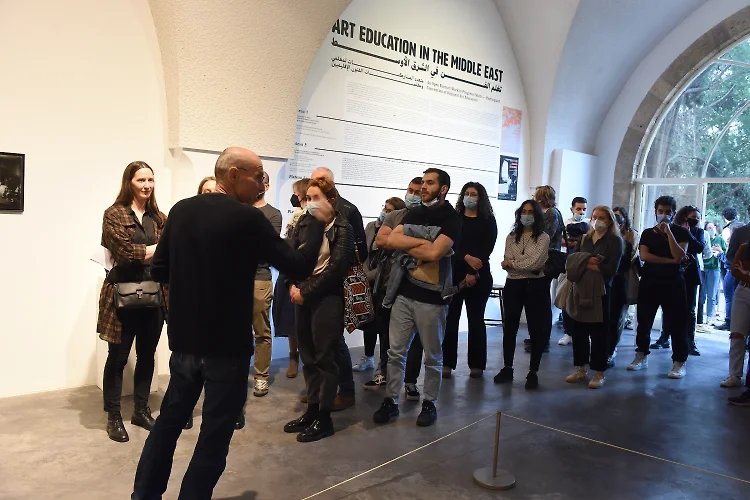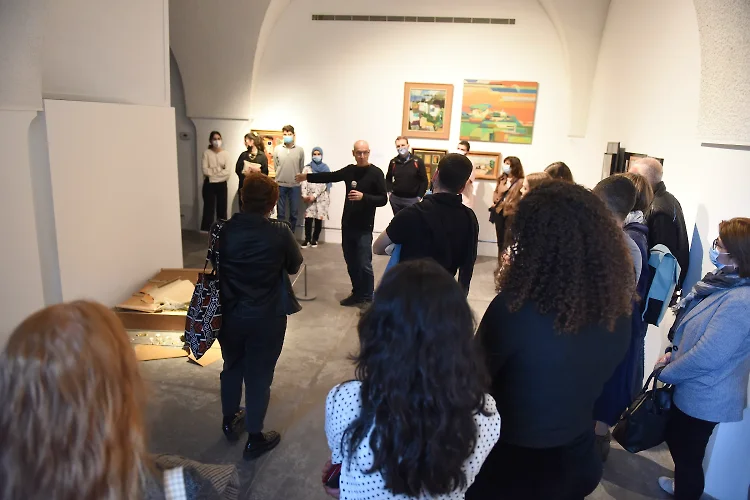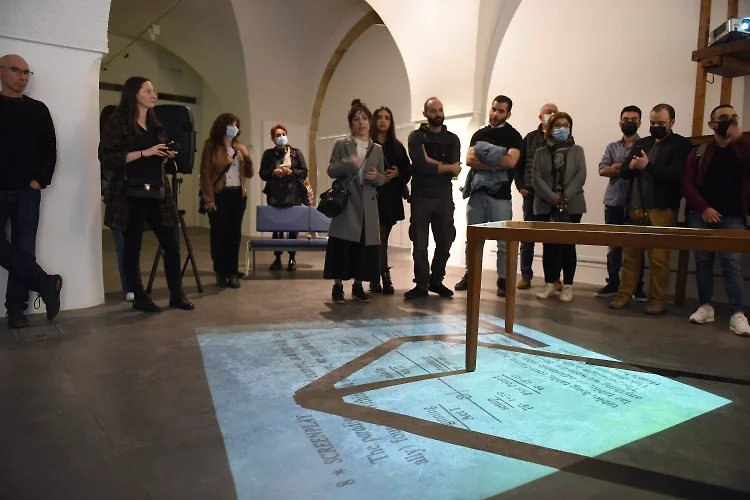IMAGE, DIGITALISATION AND TRANSMEDIALITY 2022
GuestRoomMaribor I 2022
The exhibition opened on the April 1st 2022 at the Byblos Bank Art Gallery at the American University of Beirut in Lebanon will be on view until August 2022.
Curated by Kaja Kraner, Lucija Smodiš, Miha Vipotnik and Melissa Ghazale
Participating students; Joseph Aoun, Elena Feghali, Romy-Christ Stephan from the Department of Graphic and Digital Media and Yasmin A. Kobeissi from the Department of Cinematography (Master's degree)
IMAGE, DIGITALISATION AND TRANSMEDIALITY: Emile Hannouche’s collection at USEK Department of Communication (Plateau 2)
The exhibition opened on the April 1st 2022 at the Byblos Bank Art Gallery at the American University of Beirut in Lebanon will be on view until August 2022.
Curated by Kaja Kraner, Lucija Smodiš, Miha Vipotnik and Melissa Ghazale
Participating students; Joseph Aoun, Elena Feghali, Romy-Christ Stephan from the Department of Graphic and Digital Media and Yasmin A. Kobeissi from the Department of Cinematography (Master's degree)
The exhibition continues with a presentation of Miha Vipotnik’s pedagogical activities at the
Holy Spirit University of Kaslik (USEK). The presentation derives from Vipotnik’s approach
to art education in the framework of his extra-curriculum exhibitions that are often the result
of collaboration between Lebanese and Slovene artists and curators. As such it reflects his
way of thinking about the image, technology, historical documents and the media,
characteristic of his transdisciplinary and transmedia art practice.
Originating in Fluxus and other neo-avant-garde movements of the 1960s and 1970s, inter-
and transmediality functioned as a critical intervention in the modernist idea of media purity
and presented an experimental approach to artmaking before the era of digital reproductivity.
One of the main ideas which grew out of the early debates on trans- and intermediality is that
all media (art media included) are already intermedia, since the concept of the meduim itself
implies a middle between at least two things. Trans- and intermediality in the framework of
digital reproductivity are, however, something specific. Digital form of storage namely
functions as a unifying force, nivelizing particular media and material differences while
reducing everything to its informational aspect. The latter meaning that while digitalized,
artworks not only become a potential object of mass reproduction (and by it democratization,
as already Benjamin emphacized) but aquire a new ontological status.
The starting point of the present exhibition is Emile Hannousche’s art collection that has been
entrusted to the custody of the Lebanese Maronite Order (the establisher of USEK) in 2019.
Vipotnik perceives the acquired art collection consisting of more than three thousand
paintings and other artifacts, currently located at the USEK’s Archaeological Museum and the
Emile Hannouche Museum, as a potential foundation for the future development and
extension of the existing Department of Communication into the contemporary
interdisciplinary and transmedia art education programme he has been developing in practice
over the years. While working on this exhibition which also engages with Vipotnik’s previous
exhibition projects at USEK and in the frame of Pekarna Magdalenske mreže and artist in
residency programme GuestRoomMaribor in Slovenia, we have not approached the art
collection from a scholarly art-historical point of view. Rather than that, we started from the
process of art collection’s digitalization which is already taking place – i. e. the process which
forces attention on the issues such as mediatization, reproduction, artmaking as technics and a
transformative practice, authorship, originality, and the language of particular (art) media. For
that reason, we have not treated chosen artworks from the collection as the documents with
presumptive expressive and narrative potential, i. e. as objects that reflect and symbolise
something external to itself. Instead, we were more interested in integrating a specific art
educational and creative approach with curating.
While forming the exhibition with Vipotnik’s students, we were, therefore, not so much
focused on the educational potential of national heritage but on how a particular art media and
its characteristic language develops in parallel with concurrent technological media that co-
constitutes reality and transforms perception. How the artistic and curatorial research of an art
heritage unravels complex intertwinement of artmaking, politics, and economy, or how a
particular artwork has a life of its own – especially when being kept outside the conserving
and sterile environment of an art institution that (unlike the digital form of storage)
mummificates its materiality. One way of continuing the life of a historical artwork is also its
reproduction, mediatization, creative appropriation, and decontextualization through its
inclusion into a new art or exhibition entity.
Even though we proceeded from the process of digitization of the collection – whose primary
purpose is making an inventory of the collection and making it accesible for further research
as well as for artistic exploration – we tried to emphasize material, conceptual and media
differences. Therefore, sugessted “Situations” in the exhibition can be perceived as potential
starting points for further collaboration between different art educational disciplines and
approaches.
SITUATION #1
Holy Spirit University of Kaslik (USEK). The presentation derives from Vipotnik’s approach
to art education in the framework of his extra-curriculum exhibitions that are often the result
of collaboration between Lebanese and Slovene artists and curators. As such it reflects his
way of thinking about the image, technology, historical documents and the media,
characteristic of his transdisciplinary and transmedia art practice.
Originating in Fluxus and other neo-avant-garde movements of the 1960s and 1970s, inter-
and transmediality functioned as a critical intervention in the modernist idea of media purity
and presented an experimental approach to artmaking before the era of digital reproductivity.
One of the main ideas which grew out of the early debates on trans- and intermediality is that
all media (art media included) are already intermedia, since the concept of the meduim itself
implies a middle between at least two things. Trans- and intermediality in the framework of
digital reproductivity are, however, something specific. Digital form of storage namely
functions as a unifying force, nivelizing particular media and material differences while
reducing everything to its informational aspect. The latter meaning that while digitalized,
artworks not only become a potential object of mass reproduction (and by it democratization,
as already Benjamin emphacized) but aquire a new ontological status.
The starting point of the present exhibition is Emile Hannousche’s art collection that has been
entrusted to the custody of the Lebanese Maronite Order (the establisher of USEK) in 2019.
Vipotnik perceives the acquired art collection consisting of more than three thousand
paintings and other artifacts, currently located at the USEK’s Archaeological Museum and the
Emile Hannouche Museum, as a potential foundation for the future development and
extension of the existing Department of Communication into the contemporary
interdisciplinary and transmedia art education programme he has been developing in practice
over the years. While working on this exhibition which also engages with Vipotnik’s previous
exhibition projects at USEK and in the frame of Pekarna Magdalenske mreže and artist in
residency programme GuestRoomMaribor in Slovenia, we have not approached the art
collection from a scholarly art-historical point of view. Rather than that, we started from the
process of art collection’s digitalization which is already taking place – i. e. the process which
forces attention on the issues such as mediatization, reproduction, artmaking as technics and a
transformative practice, authorship, originality, and the language of particular (art) media. For
that reason, we have not treated chosen artworks from the collection as the documents with
presumptive expressive and narrative potential, i. e. as objects that reflect and symbolise
something external to itself. Instead, we were more interested in integrating a specific art
educational and creative approach with curating.
While forming the exhibition with Vipotnik’s students, we were, therefore, not so much
focused on the educational potential of national heritage but on how a particular art media and
its characteristic language develops in parallel with concurrent technological media that co-
constitutes reality and transforms perception. How the artistic and curatorial research of an art
heritage unravels complex intertwinement of artmaking, politics, and economy, or how a
particular artwork has a life of its own – especially when being kept outside the conserving
and sterile environment of an art institution that (unlike the digital form of storage)
mummificates its materiality. One way of continuing the life of a historical artwork is also its
reproduction, mediatization, creative appropriation, and decontextualization through its
inclusion into a new art or exhibition entity.
Even though we proceeded from the process of digitization of the collection – whose primary
purpose is making an inventory of the collection and making it accesible for further research
as well as for artistic exploration – we tried to emphasize material, conceptual and media
differences. Therefore, sugessted “Situations” in the exhibition can be perceived as potential
starting points for further collaboration between different art educational disciplines and
approaches.
SITUATION #1
-
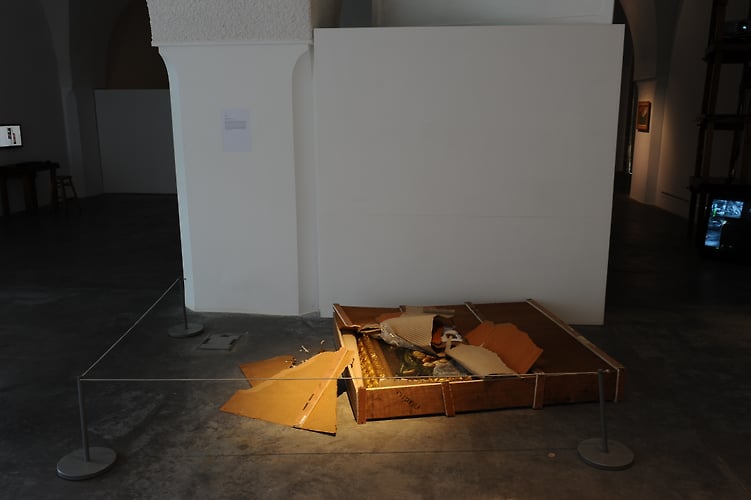
Photo: Ghazi Abou Younes
-
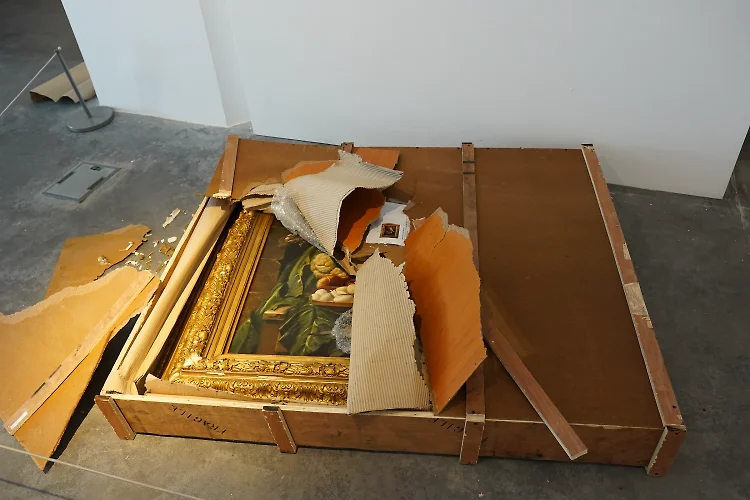
Photo: Mark Abou Farhat
-
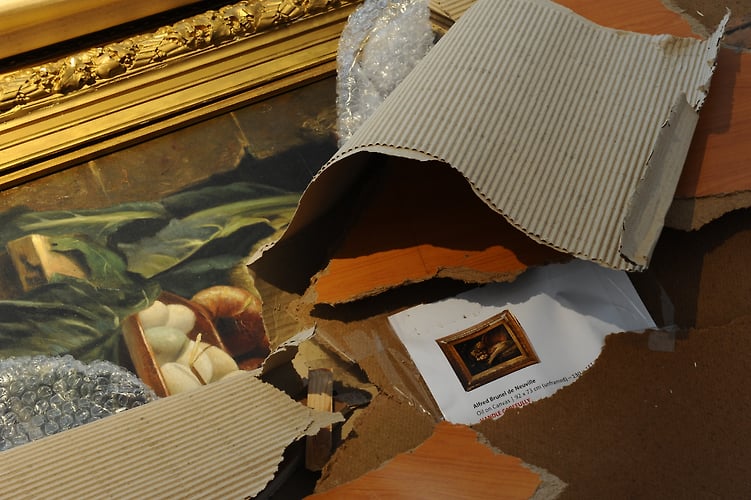
Photo: Ghazi Abou Younes
-
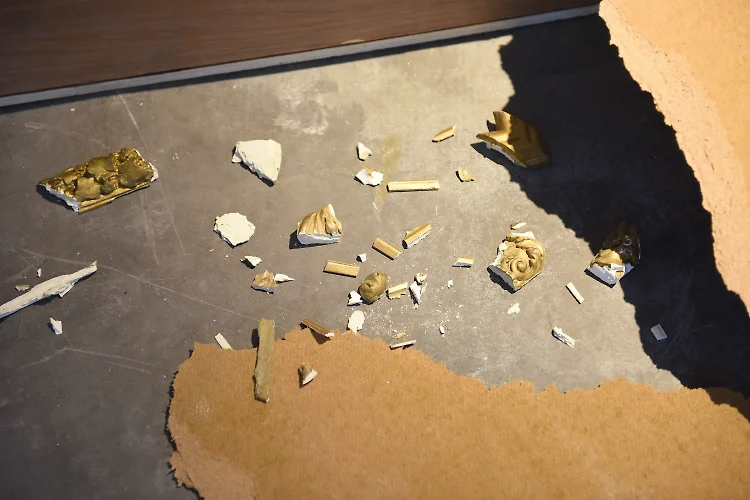
Photo: Hasan Nisr, courtesy of AUB
Alfred Brunel de Neuville
Nature morte aux poissons et légumes, 1872
89 x 69 cm
“Situation 1” is a variation of Vipotnik’s work from 2010, exhibited in the Plevnik-Kronowska Gallery in Celje (Slovenia). The original work consisted of a package used for artworks transportation, torn and just partly revealing the painting. The author of the painting in the original variation of Vipotnik’s artwork was Rihard Jakopič, one of the main Slovenian impressionist painters of the early 20th century as well as an important figure contributing to the formation of the national identity and the national art system. In other words, the hidden Jakopič painting functioned in a certain way in the Slovenian context because of his status in the Slovenian national art heritage and the development of local post-Impressionist modern art. By contrast, “Situation 1” is a 19th-century still life painting by French artist Alfred Brunel de Neuville, presenting in a rich and massive golden frame and placed in a damaged transportation box. The content of “Situation 1” is, therefore, readable exactly in comparison with the previous variation of the work.
SITUATION #2
Nature morte aux poissons et légumes, 1872
89 x 69 cm
“Situation 1” is a variation of Vipotnik’s work from 2010, exhibited in the Plevnik-Kronowska Gallery in Celje (Slovenia). The original work consisted of a package used for artworks transportation, torn and just partly revealing the painting. The author of the painting in the original variation of Vipotnik’s artwork was Rihard Jakopič, one of the main Slovenian impressionist painters of the early 20th century as well as an important figure contributing to the formation of the national identity and the national art system. In other words, the hidden Jakopič painting functioned in a certain way in the Slovenian context because of his status in the Slovenian national art heritage and the development of local post-Impressionist modern art. By contrast, “Situation 1” is a 19th-century still life painting by French artist Alfred Brunel de Neuville, presenting in a rich and massive golden frame and placed in a damaged transportation box. The content of “Situation 1” is, therefore, readable exactly in comparison with the previous variation of the work.
SITUATION #2
Vivan van Blerk
Portrait of Émile Hannouche, 2017
Collage, photographic emulsion, and glass painting
37,5 x 29,5 cm
Émile Hannouche’s portrait appears to be one of a series of commissioned portraits by Vivian van Blerk. It shows Hannouche, sitting on a sofa at his Bekaa Valley home, and is surrounded by several artifacts now included in his collection at Musée Emile Hannouche, save for the paintings and this portrait. There are two slightly different versions of the portrait, both using a mixed media technique that includes black and white photography on glass, collage, and coloration painting done from the back of the glass plate. Through this intermedial authorial approach and manipulation of the image, van Blerk attempts to portray his sitting subject in a more eloquent way, presenting his surroundings more amply than with a single instantaneous photographic shot.
“Situation 2” juxtaposes both versions of Hannouche’s portraits by van Blerk. One portrait is set with a moving backlighting, revealing the strokes of the coloring technique used, which extends the photography into the field of animation or painting. The other variation of the portrait is set with the contrasted front and back side of the portraits. “Situation 2” also encompasses two objects from the portrayed environment, namely a pillow and a marble bird representing Horus.
Until the development of digital technologies, photography was considered the most faithful and objective documentation of existing reality, since it minimized the author’s subjective mediation. By contrast, van Blerk’s photographic technique combines the objective reproduction of reality by the camera and the artist’s manual transformation of captured reality through additional collaging and coloring based on a photographic template. This aspect is particularly evident on the back of both variations of the photography. The juxtaposition of both portraits reveals the duality of this photographic document. On the one hand, it documents a certain situation from the past and results from capturing the light on a photosensitive surface. On the other hand, it documents the artist’s retroactive re-creation of this captured and mediated reality, a sort of analogue version of photo retouching that is typical especially of digital photography. Moreover, “Situation 2” adds parts of this objective reality, thus highlighting that, in this case as well, a referent (i.e., artifacts from Hannouche’s environment) functions as a document.
SITUATION #3
Portrait of Émile Hannouche, 2017
Collage, photographic emulsion, and glass painting
37,5 x 29,5 cm
Émile Hannouche’s portrait appears to be one of a series of commissioned portraits by Vivian van Blerk. It shows Hannouche, sitting on a sofa at his Bekaa Valley home, and is surrounded by several artifacts now included in his collection at Musée Emile Hannouche, save for the paintings and this portrait. There are two slightly different versions of the portrait, both using a mixed media technique that includes black and white photography on glass, collage, and coloration painting done from the back of the glass plate. Through this intermedial authorial approach and manipulation of the image, van Blerk attempts to portray his sitting subject in a more eloquent way, presenting his surroundings more amply than with a single instantaneous photographic shot.
“Situation 2” juxtaposes both versions of Hannouche’s portraits by van Blerk. One portrait is set with a moving backlighting, revealing the strokes of the coloring technique used, which extends the photography into the field of animation or painting. The other variation of the portrait is set with the contrasted front and back side of the portraits. “Situation 2” also encompasses two objects from the portrayed environment, namely a pillow and a marble bird representing Horus.
Until the development of digital technologies, photography was considered the most faithful and objective documentation of existing reality, since it minimized the author’s subjective mediation. By contrast, van Blerk’s photographic technique combines the objective reproduction of reality by the camera and the artist’s manual transformation of captured reality through additional collaging and coloring based on a photographic template. This aspect is particularly evident on the back of both variations of the photography. The juxtaposition of both portraits reveals the duality of this photographic document. On the one hand, it documents a certain situation from the past and results from capturing the light on a photosensitive surface. On the other hand, it documents the artist’s retroactive re-creation of this captured and mediated reality, a sort of analogue version of photo retouching that is typical especially of digital photography. Moreover, “Situation 2” adds parts of this objective reality, thus highlighting that, in this case as well, a referent (i.e., artifacts from Hannouche’s environment) functions as a document.
SITUATION #3
Saliba Douaihy
The Red Sunset, 1981
87 x 104 cm
Saliba Douaihy
Unknown
Shafic Abboud
Sans titre
60 x 45 cm
Shafic Abboud
View from Bikfaya, 1954
62 x 54 cm
“Situation 3” juxtaposes two pictures of a particular artist from different periods and from different phases of their authorial oeuvre. The first of Saliba Douaihy’s landscape paintings, dating from his early period, is executed in a relatively classical realist manner, and the second dates from the period after he moved to New York in the 1950s. During his stay in the USA, Douaihy met artists, such as Mark Rothko, Hans Hofmann, and Ad Reinhardt, leading to the evolution of his style towards minimalist rigour. His style gradually evolved later to the point where the link with the referent in reality is almost completely broken. At the same time, “Situation 3” juxtaposes two of Shafic Abboud’s paintings that not only reveal similar changes to the authorial oeuvre, but also indicate concurrent technological changes (cybernetics and information technology development since the late 1950s), at some point leading to the digital image and corresponding logic of the image formation.
SITUATION#4
The Red Sunset, 1981
87 x 104 cm
Saliba Douaihy
Unknown
Shafic Abboud
Sans titre
60 x 45 cm
Shafic Abboud
View from Bikfaya, 1954
62 x 54 cm
“Situation 3” juxtaposes two pictures of a particular artist from different periods and from different phases of their authorial oeuvre. The first of Saliba Douaihy’s landscape paintings, dating from his early period, is executed in a relatively classical realist manner, and the second dates from the period after he moved to New York in the 1950s. During his stay in the USA, Douaihy met artists, such as Mark Rothko, Hans Hofmann, and Ad Reinhardt, leading to the evolution of his style towards minimalist rigour. His style gradually evolved later to the point where the link with the referent in reality is almost completely broken. At the same time, “Situation 3” juxtaposes two of Shafic Abboud’s paintings that not only reveal similar changes to the authorial oeuvre, but also indicate concurrent technological changes (cybernetics and information technology development since the late 1950s), at some point leading to the digital image and corresponding logic of the image formation.
SITUATION#4
Aref Rayess
Blood and Freedom, 1971
Acrylic on canvas
60 cm x 60 cm
“Situation 4” juxtaposes Aref Rayess’ painting from 1971 and the creative appropriation of the painting executed in the technique of NFTs. Rayess is one of the most represented artists in the Émile Hannouche collection, probably owing to the collector’s personal relationship with the artist. Hannouche met Rayess at the age of 11 and the artist reportedly taught him how to draw.
The second part of “Situation 4” includes NFT artworks created by Romy-Christ Stephan. An NFT (non-fungible token) can be thought of as a form of auratization of the digitally reproduced and/or digital artworks with the medium of cryptocurrencies, creating an original through the economic transaction, i. e. buying and selling. As such, NFTs also present a technologically supported evolution of the art collecting practice. As with the 90s net art, NFTs namely have a potential to surpass the existing art system, since economic transactions are predominantly taking place without the mediator (such as gallerists, curators, and museums).
SITUATION#5
Plateau 1 Recycled
Blood and Freedom, 1971
Acrylic on canvas
60 cm x 60 cm
“Situation 4” juxtaposes Aref Rayess’ painting from 1971 and the creative appropriation of the painting executed in the technique of NFTs. Rayess is one of the most represented artists in the Émile Hannouche collection, probably owing to the collector’s personal relationship with the artist. Hannouche met Rayess at the age of 11 and the artist reportedly taught him how to draw.
The second part of “Situation 4” includes NFT artworks created by Romy-Christ Stephan. An NFT (non-fungible token) can be thought of as a form of auratization of the digitally reproduced and/or digital artworks with the medium of cryptocurrencies, creating an original through the economic transaction, i. e. buying and selling. As such, NFTs also present a technologically supported evolution of the art collecting practice. As with the 90s net art, NFTs namely have a potential to surpass the existing art system, since economic transactions are predominantly taking place without the mediator (such as gallerists, curators, and museums).
SITUATION#5
Plateau 1 Recycled
“Situation 5” is a recycled version of the first exhibition, presenting Miha Vipotnik’s previous extra-curriculum projects with his students and initially curated by Vipotnik and Melissa Ghazale. It consists of a structure constructed from the obsolete and damaged technological materials taken from the AUB junkyard. While working on “Plateau 1” and going through the junkyard, curators discovered that a lot of the equipment found there was still in working order. Therefore, they recycled the materials in such a way as to grant them aesthetic value while also putting them into use. The junkyard materials used in the installation presenting Vipotnik’s previous projects are consequently not an aestheticized document dating back to the technological past. “Situation 5” was organised in collaboration with Vipotnik’s students Rony Ghanime, Sasha Bechara, Joseph Aoun, Elena Feghali, and Yasmin A. Kobeissi.
EXHIBITION OPENING
EXHIBITION OPENING

